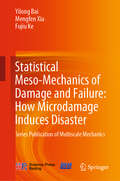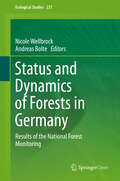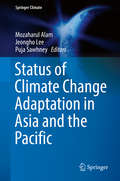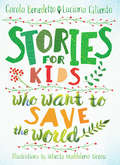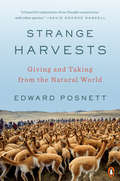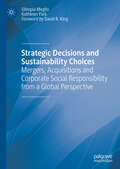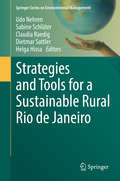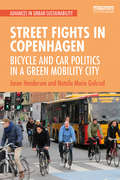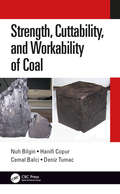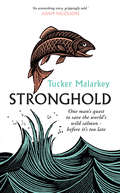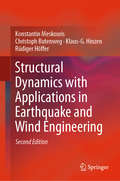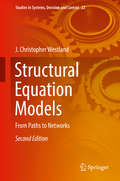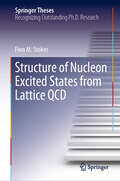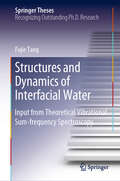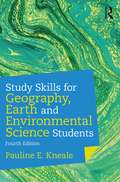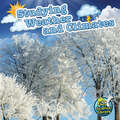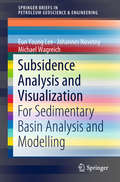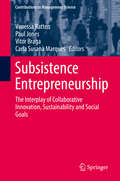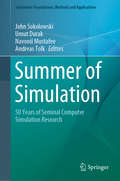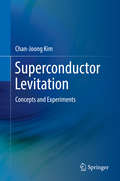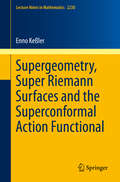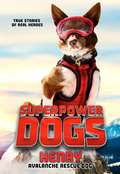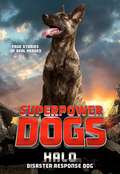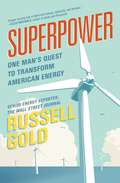- Table View
- List View
Statistical Meso-Mechanics of Damage and Failure: Series Publication of Multiscale Mechanics
by Yilong Bai Mengfen Xia Fujiu KeThis book introduces a trans-scale framework necessary for the physical understanding of breakdown behaviors and presents some new paradigm to clarify the mechanisms underlying the trans-scale processes. The book, which is based on the interaction of mechanics and statistical physics, will help to deepen the understanding of how microdamage induces disaster and benefit the forecasting of the occurrence of catastrophic rupture. It offers notes and problems in each part as interesting background and illustrative exercises.Readers of the book would be graduate students, researchers, engineers working on civil, mechanical and geo-engineering, etc. However, people with various background but interested in disaster reduction and forecasting, like applied physics, geophysics, seismology, etc., may also be interested in the book.
Status and Dynamics of Forests in Germany: Results of the National Forest Monitoring (Ecological Studies #237)
by Nicole Wellbrock Andreas BolteThis book is an open access publication.Forest ecosystems in Central Europe are changing as a result of anthropogenic influences and changing climate conditions. As such, a large-scale monitoring programme was undertaken in order to understand the influence of site modification, deposition of air pollutants, and climate. This book presents the scientific findings of this study for Germany, including the major challenges with regard to the future preservation and management of forest ecosystems under environmental change. In addition, it addresses a number of central questions: what are the main factors affecting forest stands and soil integrity? How, and how rapidly, are forest ecosystems changing? How diverse are the changes across Germany? What will be the main risks in sustainable forest management in the future? And how can policy support the development and maintenance of adaptive and resilient forests that provide essential ecosystem services, today and in the future? Helping readers understand the importance of soils and related ecosystem processes for future sustainable forestry, and sharing essential findings on environmental change and related changes in forest status and dynamics, the book is a valuable resource for researchers and policymakers interested in science-based decisions.
Status of Climate Change Adaptation in Asia and the Pacific (Springer Climate)
by Mozaharul Alam Jeongho Lee Puja SawhneyThis volume provides an overview of the climate change adaptation objectives set, actions taken, and challenges faced by several countries in the Asia-Pacific region. The majority of the populations in this region struggle to make a living from subsistence agriculture, and livelihoods are highly dependent on natural ecosystem services which are likely to be severely affected by climate change. Cases discussed in this book highlight successes made by governments towards achieving adaptation objectives, and efforts required to overcome challenges. While significant economic advances have been made, the pace of growth has been slow to impact the lives of a majority of the people who live below the poverty line. The chapters highlight adaptation actions for protecting people and their livelihoods in priority sectors, maintaining food and water security, supporting socio-economic stability including poverty reduction, and climate risk management. This book also maximizes readers' insights into the knowledge gaps and limitations of stated adaptation goals, and the bottlenecks that hinder implementation in different regions.
Stories for Kids Who Want to Save the World
by Carola Benedetto Luciana CilientoSixteen biographies of extraordinary people--ranging from Sebastião Salgado to Björk and Greta Thunberg--who came of age fighting climate changeEvery person has a path in life, one that is intertwined with the fate of the earth. The life stories in this collection begin and end with that realization. First, as children, in different countries and eras, they witness how humans provoke environmental degradation. Each leads a life that not only minimizes their individual contribution to climate change at a local scale, but also that of their generation on a global scale. Then, as adults, they recognize the maturity and agency acquired at that moment which defined their lives. The biographies depict concrete initiatives that contribute to climate preservation, from a physicist who promotes organic farming techniques in India to a designer that only uses ecological fabrics and dyes in Italy. Rock climber Yvon Chouinard, biologist Rachel Carson, and designer Adriana Santanocito are included in this diverse cast of environmental activists. Together they show us that regardless of culture, class, or profession it is never too early or late to find your way to improve the world our children will inhabit. The stakes couldn't be higher: "Our house is on fire," as Greta Thunberg rightly said.
Strange Harvests: The Hidden Histories of Seven Natural Objects
by Edward PosnettAn original and magical map of our world and its riches, formed of the stories of the small-scale harvests of seven natural objectsIn this beguiling book, Edward Posnett journeys to some of the most far-flung locales on the planet to bring us seven wonders of the natural world--eiderdown, vicuña fiber, sea silk, vegetable ivory, civet coffee, guano, and edible birds' nests--that promise ways of using nature without damaging it. To the rest of the world these materials are mere commodities, but to their harvesters they are imbued with myth, tradition, folklore, and ritual, and form part of a shared identity and history.Strange Harvests follows the journeys of these uncommon products from some of the most remote areas of the world to its most populated urban centers, drawing on the voices of the people and little-known communities who harvest, process, and trade them. Blending history, travel writing, and interviews, Posnett sets these human stories against our changing economic and ecological landscape. What do they tell us about capitalism, global market forces, and overharvesting? How do local microeconomies survive in a hyperconnected world? Is it possible for us to live together with different species? Strange Harvests makes us see the world with wonder, curiosity, and new concern.
Strategic Decisions and Sustainability Choices: Mergers, Acquisitions and Corporate Social Responsibility from a Global Perspective
by Olimpia Meglio Kathleen ParkThis book integrates two different but equally prominent themes in the management field: mergers and acquisitions (M&As) and corporate social responsibility (CSR). It explores questions such as whether strategic goals overlap or conflict with sustainability choices, what the strategic and sustainability tensions are confronting expanding companies, and whether these companies can grow and be socially responsible for a variety of stakeholders. The authors provide a fresh perspective on the study of acquisitions, aiming to inspire the M&A field and using examples from different global and institutional contexts in both developed and developing economies. This ground-breaking book addresses the gap that has existed between acquisitions on the one hand and social responsibility and sustainability on the other, for an integrative perspective on enacting M&As and achieving the triple people-planet-profits bottom line.
Strategies and Tools for a Sustainable Rural Rio de Janeiro (Springer Series On Environmental Management Ser.)
by Udo Nehren Sabine Schlϋter Claudia Raedig Dietmar Sattler Helga HissaThis book is a compilation of recent developments in land, ecosystem, and water management in the Brazilian state of Rio de Janeiro. The state is located in the biodiversity hotspot of the Atlantic Forest (Mata Atlântica), a biome characterized by high biological diversity and endemism. At the same time the state of Rio de Janeiro emerged to one of the economic hubs in Latin America. This development process has been accompanied by population growth, industrialization, urbanization, as well as consumption and degradation of land and water resources. In the past years many efforts have been made to stop or at least slow down these degradation processes and restore degraded environments with the overall goal to bring together sustainable management of natural resources, nature conservation, and economic development. An overview is provided of the different strategies and tools that have been developed in the fields of agriculture, ecosystem management and biodiversity, integrated water management, land restoration, disaster risk reduction and climate change adaptation, as well as environmental governance and economic instruments. This book covers a wide spectrum from applied research to science‐policy interfaces, planning concepts, and technical tools and has a model character for other rural areas in Latin America. Target groups are scientists, practitioners, policy makers and graduate students in the field of environmental management. The different chapters are written by researchers and practitioners of the German‐Brazilian project INTECRAL (Integrated Eco Technologies and Services for a Sustainable Rural Rio de Janeiro), the rural development program Rio Rural under the state secretary for agriculture and animal husbandry, as well as invited scientists from Brazilian universities and research institutes. It bridges existing gaps between science, policies, and practice in rural development.
Street Fights in Copenhagen: Bicycle and Car Politics in a Green Mobility City (Advances in Urban Sustainability)
by Jason Henderson Natalie Marie GulsrudWith 29 percent of all trips made by bicycle, Copenhagen is considered a model of green transport. This book considers the underlying political conditions that enabled cycling to appeal to such a wide range of citizens in Copenhagen and asks how this can be replicated elsewhere. Despite Copenhagen’s global reputation, its success has been a result of a long political struggle and is far from completely secure. Car use in Denmark is increasing, including in Copenhagen's suburbs, and new developments in Copenhagen include more parking for cars. There is a political tension in Copenhagen over the spaces for cycling, the car, and public transit. In considering examples of backlashes and conflicts over street space in Copenhagen, this book argues that the kinds of debates happening in Copenhagen are very similar to the debates regularly occurring in cities throughout the world. This makes Copenhagen more, not less, comparable to many cities around the world, including cities in the United States. This book will appeal to upper-level undergraduates and graduates in urban geography, city planning, transportation, environmental studies, as well as transportation advocates, urban policy-makers, and anyone concerned about climate change and looking to identify paths forward in their own cities and localities.
Strength, Cuttability, and Workability of Coal
by Nuh Bilgin Hanifi Copur Cemal Balci Deniz TumacWorld coal production will increase up to 2040 and world energy consumption will be very much dependent on coal. For a better planning of coal mining operations, it is essential to know the strength, cuttability and workability of coal, which are interrelated. The main objective of the book is to combine the research studies and compile the book oriented to the coal industry, research students, practicing engineers, and coal mine panning teams. Key Features Covers all the subjects related to coal properties, mining and excavation in one book Presents a summary of physical and mechanical properties of coal belonging to a wide range of countries Includes typical examples of using physical and mechanical of coal in mine planning and in its industrial applications Explains use of cuttability characteristics of coal Describes planning of coal production using ploughs, shearers and surface miners
Stronghold: One man's quest to save the world's wild salmon - before it's too late
by Tucker MalarkeyStronghold is Tucker Malarkey’s enthralling account of an unlikely visionary, Guido Rahr, and his crusade to protect the world’s last bastion of wild salmon. One of the most determined creatures on earth, salmon have succeeded in returning from the sea to their birth rivers to spawn for hundreds of thousands of years – no matter what the obstacles. But our steady incursions into their habitats mean increasingly few are making it, pushing these fish to near extinction. In this improbable and inspiring story, we follow Guido on a wild and, at times, dangerous adventure from Oregon to Alaska, and then to one of the world’s last remaining wildernesses, in the Russian Far East. Along the way, Guido contends with scientists, conservationists, Russian oligarchs and corrupt officials – and befriends some unexpected allies – in an attempt to secure a stronghold for the endangered salmon, an extraordinary keystone of our ecosystem whose demise would reverberate across the planet. This book is a remarkable work of natural history, a clarion call for a sustainable future and a riveting insight into a fish whose future is closely linked to our own. p.p1 {margin: 0.0px 0.0px 0.0px 0.0px; font: 12.0px 'Adobe Garamond Pro'} p.p2 {margin: 0.0px 0.0px 0.0px 0.0px; font: 12.0px 'Adobe Garamond Pro'; min-height: 14.0px}
Structural Dynamics with Applications in Earthquake and Wind Engineering
by Konstantin Meskouris Christoph Butenweg Klaus-G. Hinzen Rüdiger HöfferThis book offers a comprehensive introduction to the theory of structural dynamics, highlighting practical issues and illustrating applications with a large number of worked out examples. In the spirit of “learning by doing” it encourages readers to apply immediately these methods by means of the software provided, allowing them to become familiar with the broad field of structural dynamics in the process.The book is primarily focused on practical applications. Earthquake resistant design is presented in a holistic manner, discussing both the underlying geophysical concepts and the latest engineering design methods and illustrated by fully worked out examples based on the newest structural codes. The spectral characteristics of turbulent wind processes and the main analysis methods in the field of structural oscillations due to wind gusts and vortex shedding are also discussed and applications illustrated by realistic examples of slender chimney structures. The user‐friendly software employed is downloadable and can be readily used by readers to tackle their own problems.
Structural Equation Models: From Paths to Networks (Studies in Systems, Decision and Control #22)
by J. Christopher WestlandThis new edition surveys the full range of available structural equation modeling (SEM) methodologies. The book has been updated throughout to reflect the arrival of new software packages, which have made analysis much easier than in the past. Applications in a broad range of disciplines are discussed, particularly in the social sciences where many key concepts are not directly observable. This book presents SEM’s development in its proper historical context–essential to understanding the application, strengths and weaknesses of each particular method. This book also surveys the emerging path and network approaches that complement and enhance SEM, and that are growing in importance. SEM’s ability to accommodate unobservable theory constructs through latent variables is of significant importance to social scientists. Latent variable theory and application are comprehensively explained and methods are presented for extending their power, including guidelines for data preparation, sample size calculation and the special treatment of Likert scale data. Tables of software, methodologies and fit statistics provide a concise reference for any research program, helping assure that its conclusions are defensible and publishable.
Structure of Nucleon Excited States from Lattice QCD (Springer Theses)
by Finn M. StokesQuantum Chromodynamics (QCD) describes the interactions between elementary quarks and gluons as they compose the nucleons at the heart of atomic structure. The interactions give rise to complexity that can only be examined via numerical simulations on supercomputers. This work provides an introduction to the numerical simulations of lattice QCD and establishes new formalisms relevant to understanding the structure of nucleons and their excited states. The research opens with an examination of the non-trivial QCD vacuum and the emergence of “centre domains.” The focus then turns to establishing a novel Parity-Expanded Variational Analysis (PEVA) technique solving the important problem of isolating baryon states moving with finite momentum. This seminal work provides a foundation for future calculations of baryon properties. Implementation of the PEVA formalism discloses important systematic errors in conventional calculations and reveals the structure of nucleon excited states from the first principles of QCD for the first time.
Structures and Dynamics of Interfacial Water: Input from Theoretical Vibrational Sum-frequency Spectroscopy (Springer Theses)
by Fujie TangThis book focuses on the study of the interfacial water using molecular dynamics simulation and experimental sum frequency generation spectroscopy. It proposes a new definition of the free O-H groups at water-air interface and presents research on the structure and dynamics of these groups. Furthermore, it discusses the exponential decay nature of the orientation distribution of the free O-H groups of interfacial water and ascribes the origin of the down pointing free O-H groups to the presence of capillary waves on the surface. It also describes how, based on this new definition, a maximum surface H-bond density of around 200 K at ice surface was found, as the maximum results from two competing effects. Lastly, the book discusses the absorption of water molecules at the water–TiO2 interface. Providing insights into the combination of molecular dynamics simulation and experimental sum frequency generation spectroscopy, it is a valuable resource for researchers in the field.
Study Skills for Geography, Earth and Environmental Science Students
by Pauline E. KnealeThis guide will help you to survive and thrive during your degree and on into the workplace. Everything you do at university can be useful in your career. Packed with practical hints, study tips, short cuts, real-life examples and careers advice, the new expanded fourth edition of this book is an invaluable resource throughout your geography, earth science or environmental science studies. This book provides guidance for successful study on many topics including: Starting as a student Being an effective researcher Presenting information effectively in posters, presentations, essays and reports Time management, well-being and ethics Field and laboratory work Assessment and feedback Written in an accessible style, this guide also explains the role of the academic, and how it differs from that of a school teacher. It prepares you for the world of work by showing how the skills you learn at university today can be used in your career choice of tomorrow.
Studying Weather and Climates (My Science Library)
by Conrad J. StoradIntermediate Readers Explore The Difference Between Climate And Weather.
Subsidence Analysis and Visualization: For Sedimentary Basin Analysis and Modelling (SpringerBriefs in Petroleum Geoscience & Engineering)
by Eun Young Lee Johannes Novotny Michael WagreichThis book provides a comprehensive introduction to techniques for quantitative subsidence analysis and visualization with example applications. Subsidence analysis is an essential step to understand basin evolution through geologic time and space in the study of sediments and sedimentary basins. Quantifying techniques have been developed and applied in many basin research projects to evaluate total, tectonic and thermal subsidence. They are also a pre-requisite for basin evolution modelling. Recent studies have applied visualization techniques to understand regional subsidence contexts and trends, which confirmed that three-dimensional visualization of the basin subsidence is highly helpful to gain insight into basin evolution. In this book, we show how geoscience and computer science can be effectively combined in advanced basin analysis, especially in terms of basin subsidence. Each type of subsidence analysis is introduced with example applications. In particular we present a study of the Vienna basin using BasinVis, a MATLAB-based program for analyzing and visualizing basin subsidence. Given its breadth of coverage, this book will benefit students in undergraduate and postgraduate courses and provide helpful information for research projects and industry applications.
Subsistence Entrepreneurship: The Interplay of Collaborative Innovation, Sustainability and Social Goals (Contributions to Management Science)
by Paul Jones Vanessa Ratten Vitor Braga Carla Susana MarquesThis book focuses on the role of subsistence entrepreneurs in creating social and sustainable business opportunities on the global marketplace. Subsistence entrepreneurs use scarce resources to create new business opportunities, often in developing or emerging economies. In addition, subsistence entrepreneurship is increasingly being used as a way to facilitate market entry for small and medium-sized business enterprises that focus on collaborative innovation. The interdisciplinary contributions gathered here will expand readers’ understanding of the nature and characteristics of subsistence entrepreneurs, as well as the challenges they face. The central connection between subsistence, sustainability and social entrepreneurship is also explored.
Summer of Simulation: 50 Years of Seminal Computer Simulation Research (Simulation Foundations, Methods and Applications)
by Andreas Tolk Umut Durak Navonil Mustafee John SokolowskiThis book is based on the “Summer Simulation Multi-Conference” (SCSC), which has been a prominent platform for the dissemination of scholarly research in the M&S community for the last 50 years. In keeping with the conference’s seasonal title, the authors have called this half-century “the summer of simulation,” and it has led not only to simulation-based disciplines but also simulation as a discipline. This book discusses contributions from the SCSC in four sections. The first section is an introduction to the work. The second section is devoted to contributions from simulation research fellows who were associated with the SCSC, while the third section features the SCSC’s most influential contributions. Lastly, the fourth section includes contributions from the best papers in the last five years.Features:• A comprehensive volume dedicated to one of the simulation domain’s major conferences: the SCSC• Offers a scientometric analysis of the SCSC• Revisits high-impact topics from 50 years of the SCSC• Includes chapters by simulation research fellows associated with the SCSC• Presents updated best-paper contributions from the recent conferenceThis work will be of value to anyone interested in the evolution of modeling and simulation over the last fifty years. Readers will gain a perspective on what drove this evolution, and develop an understanding of the key contributions that allowed this technology to grow into its own academic discipline and profession.
Superconductor Levitation: Concepts and Experiments
by Chan-Joong KimThis book introduces the physical principles behind levitation with superconductors, and includes many examples of practical magnetic levitation demonstrations using superconducting phenomena. It features more than twenty examples of magnetic levitation in liquid nitrogen using high temperature superconductors and permanent magnets, all invented by the author. The book includes the demonstration of suspension phenomenon induced by magnetic flux pinning as well as magnetic levitation by the Meissner effect. It shows how superconducting magnetic levitation and suspension phenomena fire the imagination and provide scientific insight and inspiration. This book will be a useful experimental guide and teaching resource for those working on superconductivity, and a fascinating text for undergraduate and graduate students.
Supergeometry, Super Riemann Surfaces and the Superconformal Action Functional (Lecture Notes in Mathematics #2230)
by Enno KeßlerThis book treats the two-dimensional non-linear supersymmetric sigma model or spinning string from the perspective of supergeometry. The objective is to understand its symmetries as geometric properties of super Riemann surfaces, which are particular complex super manifolds of dimension 1|1.The first part gives an introduction to the super differential geometry of families of super manifolds. Appropriate generalizations of principal bundles, smooth families of complex manifolds and integration theory are developed.The second part studies uniformization, U(1)-structures and connections on Super Riemann surfaces and shows how the latter can be viewed as extensions of Riemann surfaces by a gravitino field. A natural geometric action functional on super Riemann surfaces is shown to reproduce the action functional of the non-linear supersymmetric sigma model using a component field formalism. The conserved currents of this action can be identified as infinitesimal deformations of the super Riemann surface. This is in surprising analogy to the theory of Riemann surfaces and the harmonic action functional on them.This volume is aimed at both theoretical physicists interested in a careful treatment of the subject and mathematicians who want to become acquainted with the potential applications of this beautiful theory.
Superpower Dogs
by CosmicMeet the real-life superheroes who walk--and bark--among us in this stunning photographic picture book featuring the stars of the IMAX film Superpower Dogs! Every single day, dogs around the world use their amazing abilities to help save lives. In over fifty dynamic photos and a fun, fact-filled text, meet some of the incredible canines who save lives, fight crime, and help people heal. Superpower Dogs is a fun and inspiring read for animal lovers of all ages, celebrating the remarkable work of heroic dogs.
Superpower Dogs: Avalanche Rescue Dog
by CosmicJoin Henry, one of the stars of the IMAX film Superpower Dogs, as he emBARKS on a journey to become an avalanche rescue dog in this gripping true story, perfect for fans of Max! In Whistler, British Columbia, dogs can be found riding chairlifts, perched on skiers' shoulders, and even descending from helicopters--all in the race against time to save people caught in the path of an avalanche. Meet Henry, a lovable border collie, and the team of dogs and human partners he works with in the beautiful and sometimes dangerous mountains. Through the action-packed narrative, informative and engaging interstitials, and eight pages of stunning full-color photographs, young readers will experience real-life rescues and gain a new appreciation for the bond between dogs and humans.
Superpower Dogs: Disaster Response Dog
by CosmicJoin Halo, one of the stars of the IMAX film Superpower Dogs, as she emBARKS on a journey to become a disaster response dog in this gripping nonfiction story, perfect for fans of Max! Dutch Shepherd puppy Halo has spent almost her whole life preparing for one job: finding people who are trapped in disaster zones. Her bond with her human partner, Fire Captain Cat, is unshakeable, and together, they can overcome any obstacle. But training to be an Urban Search and Rescue dog is tough, and it's going to take all of Cat's dedication and Halo's courage to succeed. Enhanced with breathtaking photographs and amazing canine facts, this true story of a hero's journey from adorable puppy to skilled Urban Search and Rescue dog is proof that real life superheroes walk--and bark--among us.
Superpower: One Man's Quest to Transform American Energy
by Russell GoldIn the ever more urgent quest for sources of renewable energy, meet the man boldly harnessing the natural forces that could power America’s future.The United States is in the midst of an energy transition. We want to embrace renewable energy sources like wind and solar, and rely less on dirty fossil fuels. We don’t want to keep pumping so many heat-trapping gases into the atmosphere. Any transition from a North American power grid that uses mostly fossil fuels to one that is predominantly clean requires a massive building spree—billions of dollars’ worth. Enter Michael Skelly, an infrastructure builder who began working on wind energy in 2000, when many considered the industry a joke. Eight years later, Skelly helped create the second largest wind power company in the United States—which was sold for $2 billion. Wind energy was no longer funny; it was well on its way to generating a substantial percentage of the electricity in the United States. Acclaimed journalist and author of The Boom, “the best all-around book yet on fracking” (San Francisco Chronicle), Russell Gold tells the story of this pioneer whose innovations, struggles, and persistence represent the groundbreaking changes underway in American energy. InSuperpower, we meet Skelly’s financial backers, a family that pivoted from oil exploration to renewable energy; the farmers ready to embrace the new “cash crop”; the landowners prepared to go to court to avoid looking at overhead wires; and utility executives who concoct fiendish ways to block renewable energy. Gold also shows how Skelly’s innovative company, Clean Line Energy, conceived the idea for a new power grid that would allow sunlight where abundant to light up homes thousands of miles away in cloudy states, and take wind from the Great Plains to keep air conditioners running in Atlanta. Thrilling, provocative, and important, Superpower is a fascinating look at America’s future.
